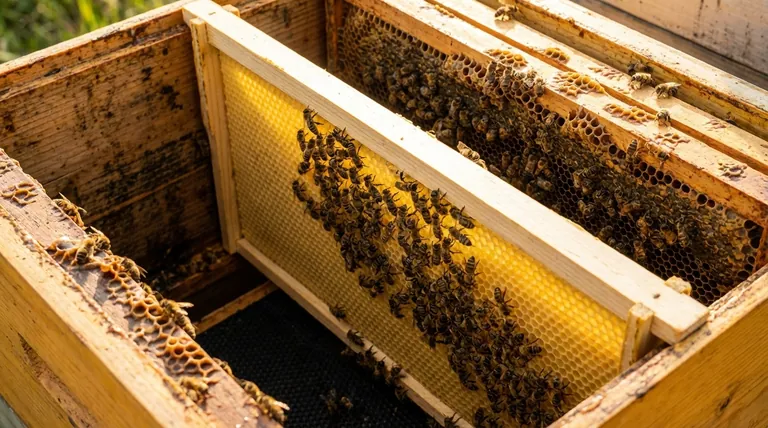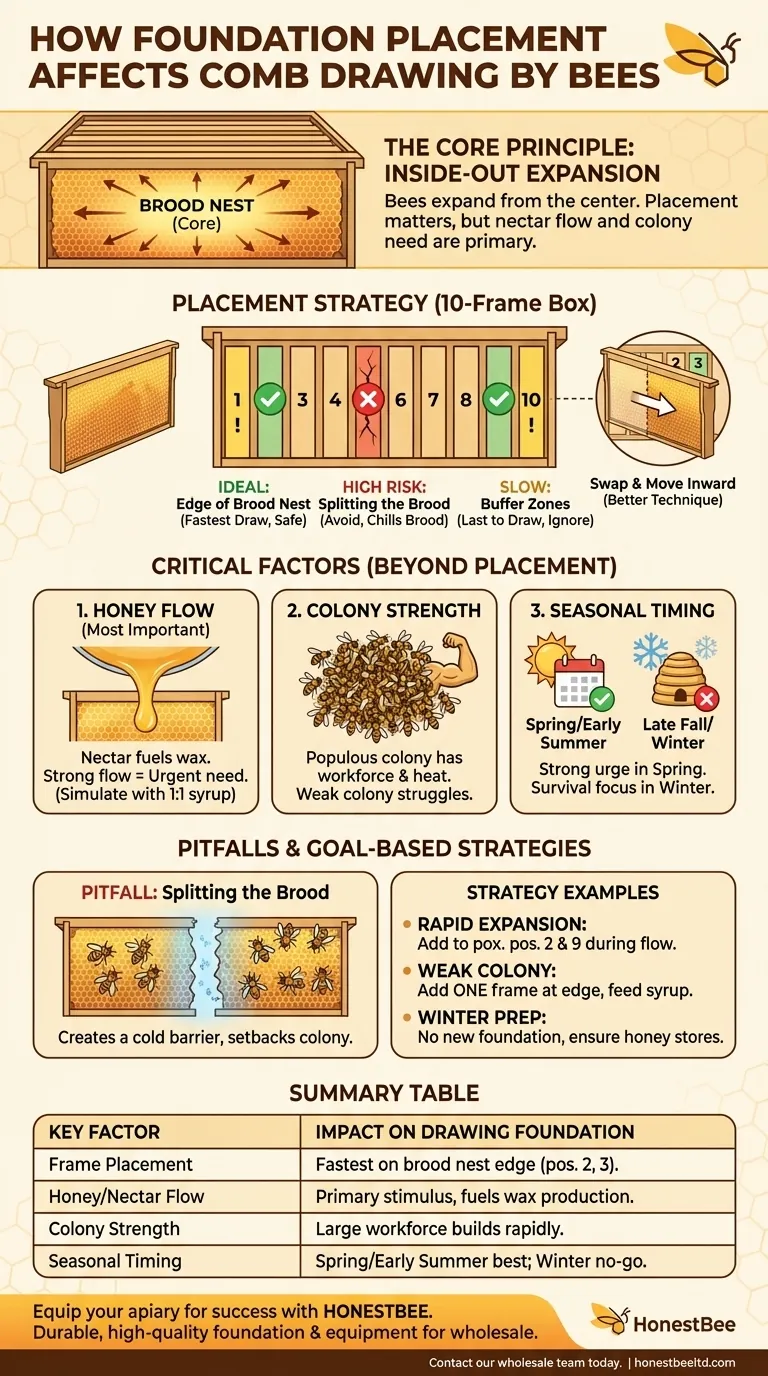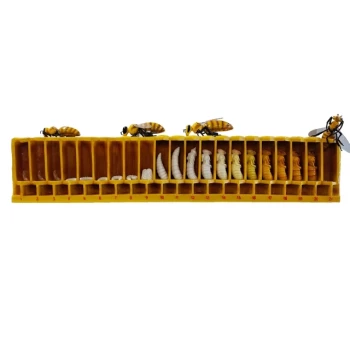To get bees to draw out foundation, you must place it where they are most active. A honeybee colony expands from the inside out, so new foundation frames are drawn most quickly when placed near the center of the brood box, adjacent to existing drawn comb.
The placement of foundation is a key factor, but it is not the most important one. Successful comb building depends primarily on the colony's urgent need for space, which is driven by a strong nectar flow, a growing population, and the right time of year.

The Core Principle: Inside-Out Expansion
A honeybee hive is a highly organized system designed for efficiency and thermal regulation. Understanding this principle is the key to working with your bees, not against them.
The Centrality of the Brood Nest
The brood nest, where the queen lays eggs and young bees are raised, is the heart of the colony. Bees maintain a precise temperature and humidity in this central area.
Because of this, colony activity and growth radiate outwards from the brood nest. This is where the most bees are, and where the need for new cells for brood and food is most immediate.
The Most Effective Placement
Placing a new frame of foundation directly in the center of the brood nest is the fastest way to get it drawn, but this is a high-risk move that can "split" the brood nest and harm the colony.
A safer and highly effective strategy is to place the new frame on the edge of the brood nest, typically in position 2 or 3 in a 10-frame box (or position 2 in an 8-frame box). This puts the foundation right next to the most active zone without disrupting the core.
Beyond Placement: Critical Factors for Drawing Comb
While placement helps, three other factors are far more critical. Without these, even perfectly placed foundation will be ignored.
The Decisive Role of Honey Flow
Bees produce wax from glands on their abdomens, a process that requires enormous energy fueled by nectar. A strong honey flow is the single most important stimulus for drawing comb.
When nectar is abundant, bees are biologically driven to build out comb to store it. If the natural flow is weak, you can simulate one by feeding the colony a 1:1 sugar syrup to stimulate wax production.
Colony Strength and Population
A small or weak colony has a limited workforce and will struggle to generate the heat and resources needed for wax building. They will prioritize keeping the existing brood warm over expanding.
A strong, populous colony has the opposite problem: they are running out of space. This creates the internal pressure needed to build new comb rapidly. A small hive might only build out half a frame at a time.
Seasonal Timing
Bees have an annual cycle of expansion and contraction. The strongest urge to expand is in the spring and early summer, coinciding with population growth and the main honey flow.
In late fall and winter, the colony's focus shifts entirely to survival and conservation. They will not draw new comb, regardless of where you place the foundation.
Understanding the Trade-offs and Pitfalls
Incorrectly adding foundation can slow a colony's progress or even cause harm.
The Risk of Splitting the Brood
Placing a frame of empty foundation in the absolute center of the brood nest creates a barrier. The bees must now work to maintain temperature and communication across a cold, empty gap.
This "splitting" of the brood nest can chill the developing bees, disrupt the queen's laying pattern, and set the colony back significantly. It should be avoided by less experienced beekeepers.
When Bees Ignore Outer Frames
It is completely normal for bees to ignore the frames on the outermost edges of the box (positions 1 and 10). These act as buffer zones for temperature and are the last places they will expand into.
If you have undrawn frames on the outside, do not move them all to the center. A better technique is to swap one of these outer frames with a fully drawn frame from position 3 or 4, moving the drawn comb to the outside and the foundation inward.
Making the Right Choice for Your Goal
Your strategy should adapt to the specific conditions of your hive and the season.
- If your primary focus is rapid expansion during a strong nectar flow: Place foundation frames in positions 2 and 9 (in a 10-frame hive), or swap one undrawn frame into position 3.
- If your primary focus is supporting a new or weak colony: Place only one frame of foundation on the edge of their small cluster and feed them 1:1 syrup continuously.
- If your primary focus is preparing for winter: Do not add any new foundation; instead, ensure they have fully drawn-out frames filled with honey.
By understanding the colony's needs, you can provide the right support at the right time.
Summary Table:
| Key Factor | Impact on Drawing Foundation |
|---|---|
| Frame Placement | Foundation draws fastest when placed on the edge of the brood nest (e.g., position 2 or 3 in a 10-frame box). |
| Honey/Nectar Flow | The single most important factor. A strong flow provides the energy and stimulus for wax production. |
| Colony Strength | A large, populous colony has the workforce and need for space to build comb rapidly. |
| Seasonal Timing | Spring and early summer are the best times; bees won't build comb in late fall or winter. |
Equip your apiary for success with HONESTBEE.
Whether you are a commercial apiary scaling up operations or a beekeeping equipment distributor stocking for the season, the right supplies are crucial for efficient comb building and hive health. HONESTBEE supplies durable, high-quality foundation and beekeeping equipment through our wholesale-focused operations, helping you support strong, productive colonies.
Contact our wholesale team today to discuss your needs and get a quote.
Visual Guide

Related Products
- Notebook Style Beeswax Foundation Mould Wax Foundation Mold
- Manual Beeswax Comb Foundation Machine Wax Foundation Mill Embossing Machine
- Food Grade Plastic bee Foundation for Bee Frames
- Electric Beeswax Foundation Machine With Operating Tray and Wax Foundation Roller
- Electric Flatting and Embossing Machine with Tray for Beekeeping
People Also Ask
- How do you use the Foundation Mold to create beeswax foundation? Master DIY Beekeeping with Precision
- How is beeswax foundation installed and what are its characteristics? Boost Hive Health Naturally
- What are the uses of recycled beeswax cappings? Transform Honey Byproducts into Valuable Assets
- What is the process for making beeswax sheets using a mold? A Step-by-Step Guide for Perfect Results
- What is required when using wax foundation in beekeeping frames? Essential Support for Strong Combs



















